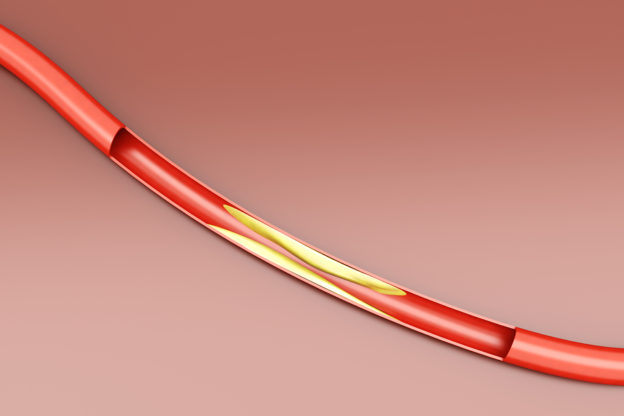By David Blyweiss, M.D., Advanced Natural Wellness
July 29, 2019
My father, brothers, and uncles all suffered from heart attacks. They also all had one strange physical sign – creased earlobes!
Believe it or not, this is a warning sign that your arteries may be at increased risk for clogging – and there are well over 50 studies to prove it. (Look for a crease that runs diagonally from the top of your earlobe to the lower edge of your earlobe.)
Earlobe creases form because of weakened then folded collagen in your ears. It’s also a sign of weakened collagen elsewhere…especially in your arteries. Once this symptom appears, it’s really important for you to take note.
In fact, when my own earlobe creases appeared, I switched to a mostly plant-based diet.
Over the years, I’ve found there are several advance warning signs that can occur when plaque builds up in your arteries.
Of course, the only way to know for sure is to get an angiogram test. But usually people only get these if they fail a stress test or suffer a cardiovascular event.
So what are other ways to detect blocked blood vessels?
Achy Back
MD Exposes the Hidden Danger to Your Eyes

When your eyesight starts to fail, it's a real problem. Suddenly you can't go to the grocery store... you can't get to the doctor if you have an emergency... you can't meet your friends for dinner…
Your "regular" doctor doesn't have time to keep up with the latest research. And the same goes for eye doctors. They go to school to learn how to fit you for glasses and contacts, but have no way of preventing the damage and loss of eyesight that threatens your freedom and independence.
Let me show you something that explains a LOT about how your eyes work.
In my FREE Special Report, I'll show you a HUGE, untapped resource for your eyes that safely and naturally restores clear, effortless eyesight.
Click here to get started...
After you check for creased arteries, stop to think how your back is feeling.
Is it stiff, tender or achy? Have you been told your discs are degenerating? Do you have a touch of spinal arthritis?
All of these – disc degeneration, arthritis and lower back pain – are associated with arterial plaque and blockages in the lumbar arteries. Blocked arteries can slow the blood flow to your spine, so your vertebrate can’t get the oxygen and nutrients it needs to do its’ job properly.
So, if you’re having back pain, an MRI or CT scan may not be what you need. It’s possible your doctor should be looking for vascular disease instead.
Trouble with Arousal
For men, the first sign of cardiovascular disease is trouble getting erect. Don’t jump to the conclusion you’re just short on testosterone.
Almost all cases of ED are directly related to circulatory problems. If you’re not getting blood to the groin area, there’s a good chance arteries throughout your body are in trouble.
The connection is so strong, these days, many experts suggest all men with ED be screened for heart disease; something I completely agree with.
The same thing holds true for women. Women who have trouble getting aroused – where blood can’t flow to the genitalia – may also be at risk.
Hair Loss
If you’re losing hair on the top of your head, this could be another symptom of circulatory problems. This goes for men and women alike.
Take this one seriously, folks. Because hair loss due to poor circulation has an especially high risk for a heart attack.
Leg Pain
Are You Suffering From...
- Love handles and a pot belly
- Romance that isn't what it used to
- Forgetfulness and inattention
- Low (or no) strength and endurance
- A sex drive that's shifted into neutral...or worse
If so...you may have Mature Male Burnout. Click here to discover more about this unique condition and what you can do about it.
Finally, do you often experience leg pain while you’re walking? Achy calves that just won’t go away?
If so, it could be another sign that arteries in your legs are blocked or narrowed. This is a symptom that often shows up well before a coronary event.
Time to Get Serious about Taking Care of Your Arteries
If you’re like me and notice any one of these symptoms, you may be perfectly fine.
But if you have two, three or four… Well, I’d say it’s time to get serious about taking care of your arteries before you end up with a heart attack or stroke.
One of the easiest things to do is to switch to a mostly whole food plant-based diet. It’s what I’ve personally done to lower my risk of a cardiac event.
It takes less than one year for this eating plan to open arteries, reduce plaque, stop shortness of breath, burn away fat, and result in a healthier you.
It’s an easy fix…
But when it comes to arterial health, there are some extra measures you can take.
First, off, I like garlic. It helps keep your blood cells from clumping together. It also helps stop LDL cholesterol from oxidizing, which can reduce plaque build-up. Plus, it helps lower blood pressure and reduces arterial stiffness. Take 600 mg. of Kyolic brand aged garlic extract twice daily.
Niacin is another good choice. It helps prevent damage and plaque accumulation in your arteries by reducing the number of small, dense LDL particles that can lodge in the walls of your arteries.
Start on a low 100 mg dose daily and slowly build up by 100 mg a week to a max of 500 mg per day. The “niacin flush” is a common side effect, which will turn the surface of your skin red. This happens because the niacin opens your capillaries and brings more blood flow to the surface of your skin.
Finally, try adding a plant-based nitric oxide enhancer to your daily regimen. Nitric oxide (or NO) relaxes your arteries, reduces blood pressure and improves blood flow throughout your body.
One of my favorite ways to get NO into my diet is by drinking beet root juice. I had an 87-year-old patient who taught me to drink it with the juice of one lemon, three apples and a one inch chunk of ginger root added in to either four ounces of beet juice (in the refrigerated section of Costco…or two-three juiced red beets). Ginger was the real trick… it was like beetroot juice with attitude!
If you don’t like the taste of beetroot juice, look for a nitric oxide enhancing supplement that has beetroot as a main ingredient.
SOURCES:
Kauppila LI. Atherosclerosis and disc degeneration/low-back pain—a systematic review. Eur J Vasc Endovasc Surg. 2009 Jun;37(6):661-70.
Beckworth W, et al. Atherosclerotic Disease and Its Relationship to Lumbar Degenerative Disc Disease, Facet Arthritis, and Stenosis Using Computed Tomography Angiography. Presented at the 2016 AAPM Annual Meeting
Agouridis AP, et al. Ear lobe crease: a marker of coronary artery disease? Arch Med Sci. 2015 Dec 10; 11(6): 1145–1155.
Pastuszak AW, et al. Erectile dysfunction as a marker for cardiovascular disease diagnosis and intervention: a cost analysis. J Sex Med. 2015 Apr;12(4):975-84.
Sharma L, et al. Androgenetic alopecia and risk of coronary artery disease. Indian Dermatol Online J. 2013 Oct;4(4):283-7.
Allison GL, et al. Aged garlic extract and its constituents inhibit platelet aggregation through multiple mechanisms. J Nutr. 2006 Mar;136(3 Suppl):782S-788S.
Ried K, et al. The effect of aged garlic extract on blood pressure and other cardiovascular risk factors in uncontrolled hypertensives: the AGE at Heart trial. Integr Blood Press Control. 2016 Jan 27;9:9-21.
Morgan JM, et al. Effects of extended-release niacin on lipoprotein subclass distribution. Am J Cardiol. 2003 Jun 15;91(12):1432-6.
Kapil V, et al. Dietary nitrate provides sustained blood pressure lowering in hypertensive patients: a randomized, phase 2, double-blind, placebo-controlled study. Hypertension. 2015 Feb;65(2):320-7







